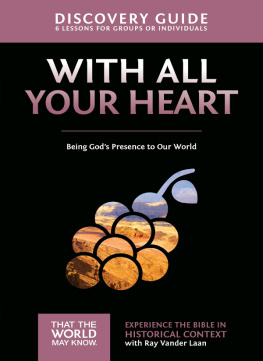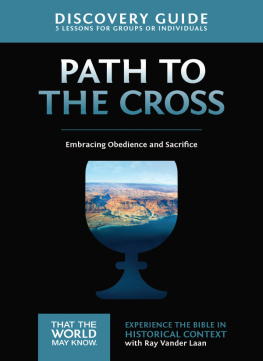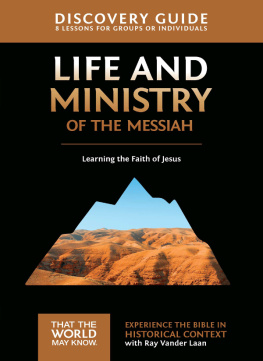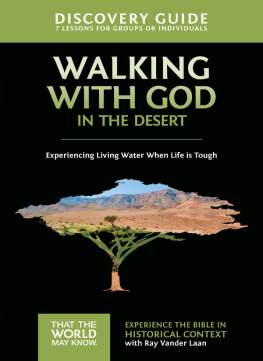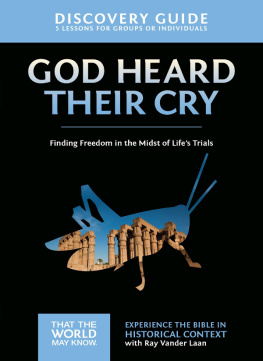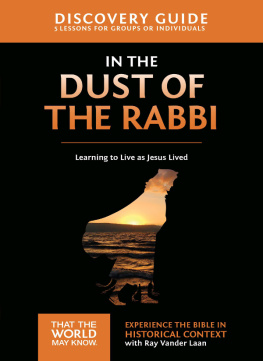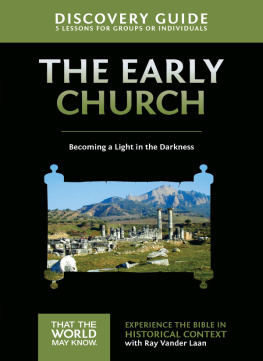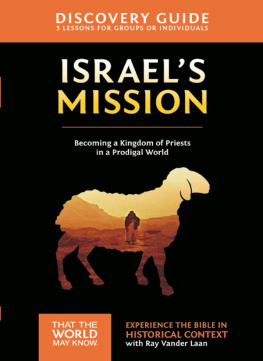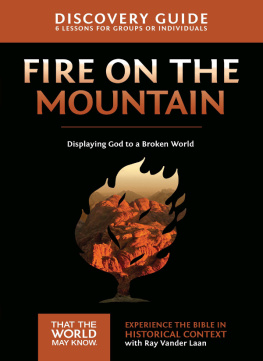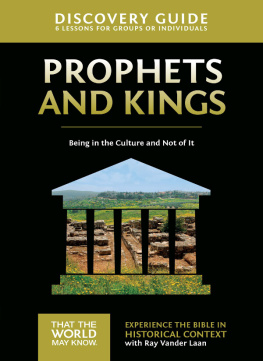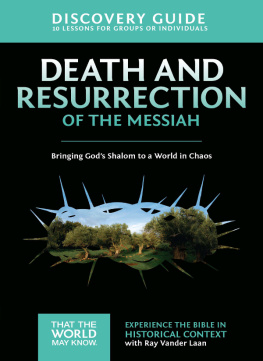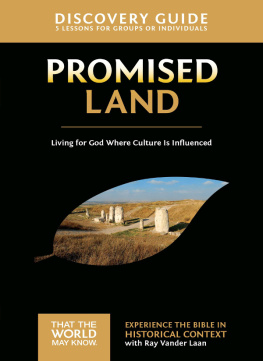That the World May Know with Ray Vander Laan
Volume 1: Promised Land
Volume 2: Prophets and Kings
Volume 3: Life and Ministry of the Messiah
Volume 4: Death and Resurrection of the Messiah
Volume 5: Early Church
Volume 6: In the Dust of the Rabbi
Volume 7: Walk as Jesus Walked
Volume 8: God Heard Their Cry
Volume 9: Fire on the Mountain
Volume 10: With All Your Heart
Volume 11: The Path to the Cross
Volume 12: Walking with God in the Desert
Volume 13: Israels Mission
ZONDERVAN
With All Your Heart Discovery Guide
Copyright 2010 by Ray Vander Laan
Requests for information should be addressed to:
Zondervan, 3900 Sparks Dr. SE, Grand Rapids, Michigan 49546
Focus on the Family and the accompanying logo and design are federally registered trademarks of Focus on the Family, 8605 Explorer Drive, Colorado Springs, Colorado 80920.
That the World May Know is a trademark of Focus on the Family.
ePub Edition September 2015: ISBN 978-0-310-87983-1
All maps are created by International Mapping.
All photos are courtesy of Ray Vander Laan and Mark Tanis.
All illustrations are courtesy of Drew Johnson except pages 25 and 162 (Rob Perry).
All Scripture quotations are taken from The Holy Bible, New International Version, NIV. Copyright 1973, 1978, 1984 by Biblica, Inc. Used by permission. All rights reserved worldwide.
Any Internet addresses (websites, blogs, etc.) and telephone numbers in this book are offered as a resource. They are not intended in any way to be or imply an endorsement by Zondervan, nor does Zondervan vouch for the content of these sites and numbers for the life of this book.
All rights reserved. No part of this publication may be reproduced, stored in a retrieval system, or transmitted in any form or by any means electronic, mechanical, photocopy, recording, or any other except for brief quotations in printed reviews, without the prior permission of the publisher.
Cover design: DoMoreGood
Cover photography: BiblePlaces.com; Getty Images
Interior design: Ben Fetterley, Denise Froehlich
CONTENTS
Ebook Instructions
In this ebook edition, please use your devices note-taking function to record your thoughts wherever you see the bracketed instructions [Your Notes] or [Your Response]. Use your devices highlighting function to record your response whenever you are asked to checkmark, circle, underline, or otherwise indicate your answer(s).
Remember how the LORD your God led you all the way in the desert these forty years.
Deuteronomy 8:2
The exodus of the Hebrew people from Egypt to the Promised Land was more than a compassionate act of divine deliverance. It was Gods calling of a people to be his treasured possession, kingdom of priests, and holy nation who would put him on display for the whole world to see (Exodus 19:4 6). God, in effect, took Israel as his bride, and the people promised to do everything God commanded. But vows do not make a marriage, and the Israelites would have to learn to love and obey their God.
That is what the years of discipline and testing in the desert would accomplish. God would live among his chosen people in the tabernacle and through that intimate relationship would mold and shape them to be a people who would be his faithful witnesses to the entire world. Yes, they would fail, and we can learn much from their stubborn disobedience. But they were not failures. The children they parented were ready to take the next step in Gods great plan to restore shalom to a broken world. They were ready to face the final test: to live in obedience to Gods every word and to continue to depend on him for everything they needed in a land blessed with abundance.
Few events are more central to the stories of both the Hebrew text (Old Testament) and the Christian text (New Testament) than the great redemptive acts of God and the people of the exodus. The Hebrew text refers to the exodus theme more than 120 times, plus there are multiple references to related concepts such as manna, water from the rock, Mount Sinai, and the Ten Commandments. The Christian text mentions Moses eighty-five times and Egypt twenty-nine times.
Yet there is more to the exodus than first meets the eye. The historical account is most useful in understanding God and his desire for the Hebrews to become his witnesses to the world. It is central to understanding why many followers of Jesus considered him to be the prophet like Moses the Messiah whom the Lord had promised to send (Deuteronomy 18:17 19; Luke 7:16; 24:19 20; John 6:14). Jesus often used ideas found in the exodus story, and many of his teachings interpret Moses words in the Torah. Jesus also positioned his redemptive acts against the background of festivals Passover, Unleavened Bread, and First Fruits that are associated with the Hebrews deliverance from Egypt. And at the deepest level, the exodus story not only provides a background for Gods plan to bring Jesus into the world as Messiah, it is one of the first chapters in Gods great redemptive story to restore shalom unity, harmony, order to his broken creation.
Genesis, the first book of the Torah, provides the necessary background for the exodus. Genesis describes God creating a perfect, harmonious universe out of chaos and then describes how sin destroyed that universe, resulting in the loss of harmony in Gods creation and the return of chaos. In the stories of the exodus we find the very foundations of the restoration of shalom to Gods world. Future characters in the Scriptures, including Jesus, build on that foundation. To study these amazing events is to discover that there is really one story the story of Gods redemption. Despite the many failures of Gods people in fulfilling their role in that story, Gods power has and continues to flow through his flawed human instruments (Jesus excepted, of course) to bring to fruition his plan of redemption.
Thus the exodus is a paradigm for our own experience, and we Christians describe our deliverance in similar language because God delivers us by his mercy and the protecting blood of the Lamb Jesus Christ. Without the exodus, we would not be who we are redeemed people delivered by the God of Israel. And without the hardships of the desert experience, we would find it difficult to learn how to live in intimate dependence on his provision and by faithful obedience to his every word.
Clarifying Our Terminology
In this study, the record of Gods reclaiming and restoring his broken world is called the Bible, Scripture, or the text. Having studied in the Jewish world, I believe it is important to communicate clearly how the nature of that inspired book is understood. Although it can be helpful to speak of Scripture in terms of Old and New Testaments, these descriptions also can be misleading if they are interpreted to mean old and outdated in contrast to a new replacement. Nothing, in my opinion, is further from the truth. Whereas the New Testament describes the great advance of Gods plan with the arrival of the Messiah and the promise of his completed and continuing work, the Old Testament describes the foundational events and people through whom God began that work. The Bible is not complete without both testaments; it comprises Gods one revelation, his one plan to reclaim his world and restore harmony between himself and humankind. To emphasize that unity, I prefer to refer to the Hebrew text (Old Testament) and the Christian text (New Testament) that together are the inspired, infallible Word of God.
The language of the Bible is bound by culture and time. The geography of the lands of the Bible Egypt, the desert, the Promised Land shaped the people who lived there, and biblical writers assumed that their readers were familiar with the culture of that world. Many Christians today, however, lack even a basic geographical knowledge of the region and know even less of the ancient cultures that flourished there. So understanding the Scriptures involves more than knowing what the words mean. It also means becoming familiar with the everyday experiences and images the text employs to reveal Gods message so that we can begin to understand it from the perspective of the people to whom it originally was given.
Next page
